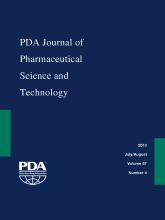Abstract
This study investigated the capability of three rapid microbiological methods to detect microorganisms in aseptically prepared pharmacy preparations at National Health Service hospitals in the United Kingdom. BacT/ALERT 3D (bioMerieux), AKuScreen (Celsis), and BactiFlow ALS (AES Chemunex) technologies were used to detect levels of microorganisms in pharmaceutical products. Four products selected to represent the range of pharmaceuticals prepared in National Health Service hospital pharmacy departments were spiked with known levels of microorganisms. The presence of microorganisms in these products was then determined using each of the rapid microbiological methods and compared to the number determined by traditional total aerobic microbial count methodology. An evaluation of the performance parameters associated with each of the methods, including cost analysis, was also undertaken. There was good correlation between rapid microbiological methods and total aerobic microbial count for heparin and parenteral nutrition products. The rapid microbiological methods had difficulty recovering Gram-positive organisms from vancomycin and methotrexate products; however, protocol developments demonstrated that this was surmountable. The main differences between the rapid microbiological method systems were time-to-result, the initial equipment cost, and the skill required to operate the instruments. The main finding from this work is that rapid microbiological methods can detect microbial contamination of hospital pharmaceutical products in a reduced time when compared to traditional microbiological techniques. The instrument comparison showed that Celsis AKuScreen provided the most rapid result for detecting bacteria; BacT/ALERT was the least expensive instrument and the simplest system to use; and BactiFlow ALS was the most expensive and more complex to use and gave intermediate time to results.
LAY ABSTRACT: Traditional methods to assure quality and detect any microbial contaminants in intravenous products takes at least 2 weeks to complete. Hospital-prepared intravenous products are often high risk and have short shelf lives. This sometimes means that the traditional quality microbiological results are only available after the product has been administered to the patient. There have been some fatal incidents in which contaminated intravenous products have been used. Rapid microbiological methods have been used in the food, cosmetic, and pharmaceutical industries; however, they have not as yet been used in United Kingdom National Health Service pharmacy manufacturing. Rapid microbiological methods are able to detect contaminants in shortened periods of time. This study investigates the ability of three rapid microbiological methods to detect artificially contaminated, National Health Service–prepared intravenous products and compares the results to those obtained from traditional total aerobic microbial count methodology. The results show that there are differences between the methods; however, generally rapid microbiological methods are able to detect contaminants from pharmacy-prepared intravenous products quicker than current traditional methods.
- © PDA, Inc. 2013
PDA members receive access to all articles published in the current year and previous volume year. Institutional subscribers received access to all content. Log in below to receive access to this article if you are either of these.
If you are neither or you are a PDA member trying to access an article outside of your membership license, then you must purchase access to this article (below). If you do not have a username or password for JPST, you will be required to create an account prior to purchasing.
Full issue PDFs are for PDA members only.
Note to pda.org users
The PDA and PDA bookstore websites (www.pda.org and www.pda.org/bookstore) are separate websites from the PDA JPST website. When you first join PDA, your initial UserID and Password are sent to HighWirePress to create your PDA JPST account. Subsequent UserrID and Password changes required at the PDA websites will not pass on to PDA JPST and vice versa. If you forget your PDA JPST UserID and/or Password, you can request help to retrieve UserID and reset Password below.






